In the Beginning . . .
. . . the summer heat beat down and the earth beat back up.
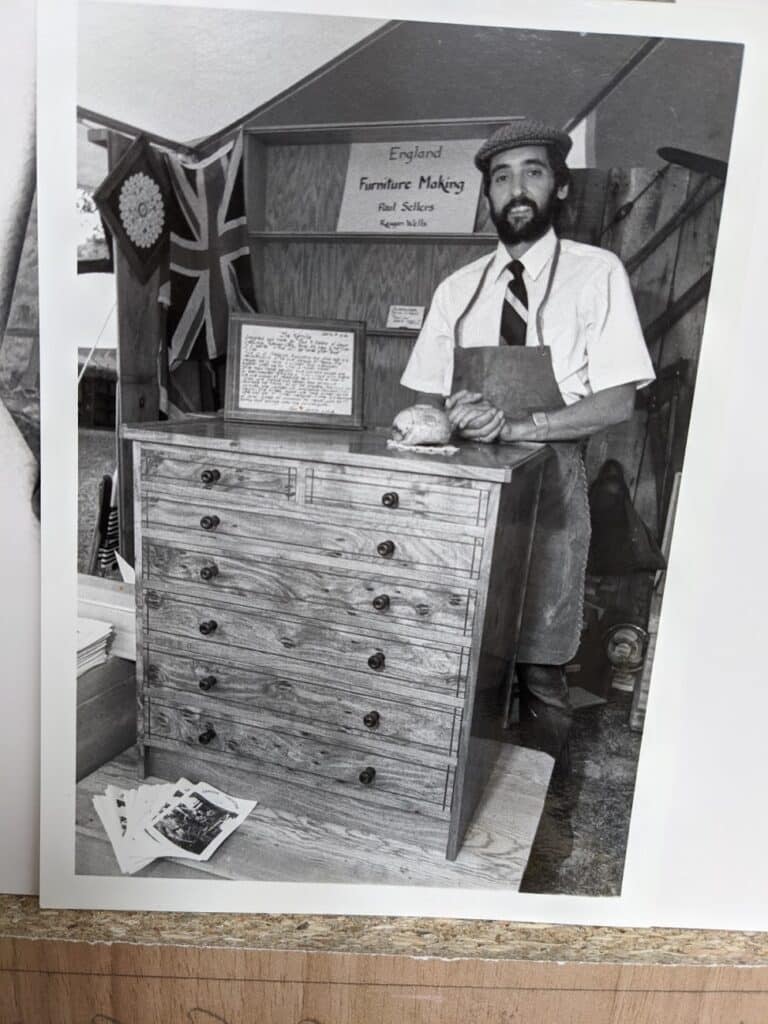
August, September, where the sun beats down heavily with increasing power and from the weeks and months before the earth radiates relentlessly back long after the day’s end. Relief comes only beneath the live oak’s outspread umbrella and from floating the Rio Frio or the Guadalupe in a truck tube. Even so, still, be prepared to fry. Shade overhead helps but earth radiating from a Texas summer sun seems never-ending. There’s the build-up you see. Each day sees an increase. In Fahrenheit we’re around 109º, that’s around 42º Celcius give or take. I’m at the annual Texas State Fair in Kerrville beneath a cedar-covered brush arbor, US spelling, arbour, UK and Canada. It’s 4 pm and there is no escaping the heat. The brush arbor works to shade from above but the earth is another matter. The Texas Arts and Crafts Foundation developed this year’s theme to replicate settlers moving west as tradesmen and women filled with the hope of settling and setting up temporary workplaces to practise and ply their wares as they passed. I’m the resident furniture maker newly arrived from my native England (not far from the truth). I am to establish myself as a furniture maker in the Hill Country of Texas. The local towns are a mix of small cowboy towns, German settlements, people claiming new life on a new continent. I have just about set up the workshop to my liking, tools, wood, workbench. I’m feeling a buzz. I have some of my newly made furniture pieces around me. Unusual styles for the Texas audience but mesquite has the draw. Nobody l knew mesquite could be so “Purdy!”.
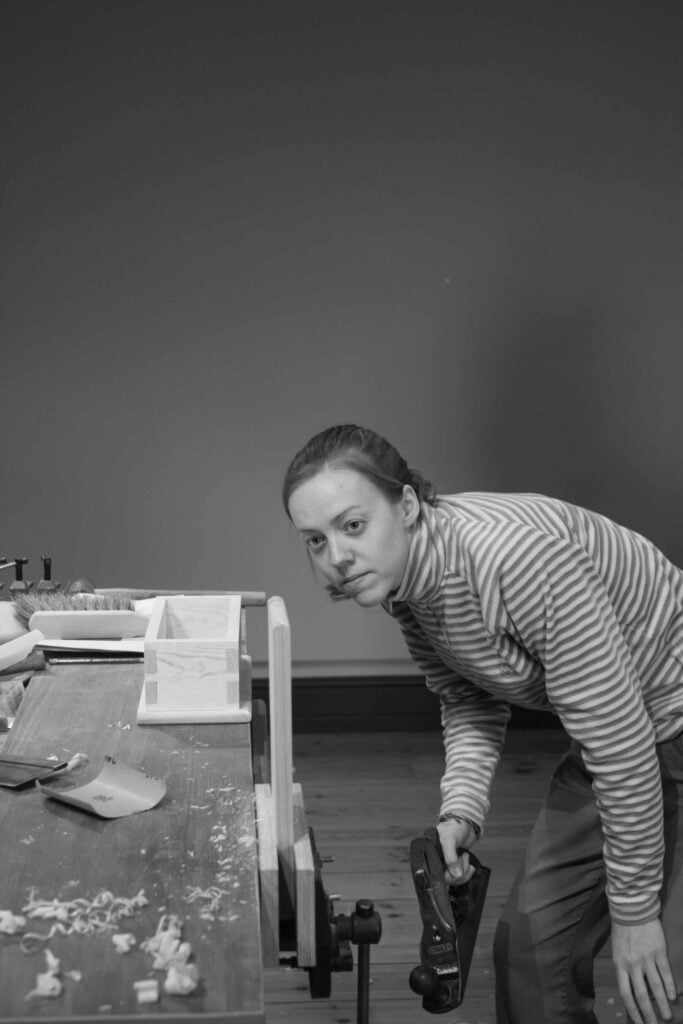
It wasn’t easy for me there in Texas, starting up from nothing. The thing that made it work for me was the kind ways most of the local Texans extended to me. Chillie cook-offs somewhere along the canyon in someone’s back yard of a thousand acres where a realtor lands his Cessna on a sandy runway after his commute to Houston and business. They could be tough, maybe a little rough around the edges in some, but their openness and kindness were unsurpassed, that’s in my experience at least. But the sales of a couple of pieces at the show really helped cover a few bills. My home workshop and home were 32 miles from the nearest town and 16 miles into the dead-end Frio canyon. You drove through five low river crossings to get there and halfway in you thought you had taken the wrong road. It was quiet and peaceful and much nicer and friendlier than Manchester, England. Every few hours a small plane would buzz across the sky one way or another. I’d look up and wonder who he was and where he was going. Wonder what he could see from up there.
At the close of my long weekend demonstrating and talking to people, just before the show closedown, Audie Hamilton, the show director asked if I would teach a woodworking workshop for them. At first, I thought, No, but I relented and said OK. The upshot was that this single event back in 1990 would be the springboard that launched me towards the international outreach we now have. Who would have thought? The rest is history and history it may be, but it was from this that I began to think more closely about the future of woodworking as a craft. What did it now mean and what did it matter if it died? The writing for me was clearly on the wall. The only woodworkers I ever met in the previous few years never used any hand tools. If it didn’t come off a rotary cut it didn’t get used. In teaching students how to slice out a dovetail with saw strokes and chisels the ingredient for success started to gestate. What was that? Simple. It was having a burden!
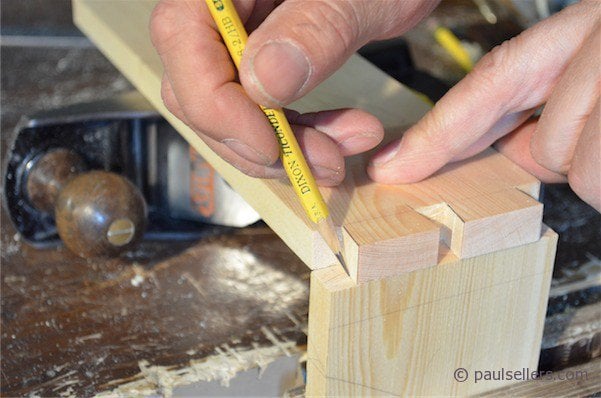
At the fair, the men gathered around the bench two deep and full length and around both ends. Each demonstration throughout the day it was the same. I made dovetails in a couple of minutes sometimes and at others took more time. Housing dadoes came the same way and then moulded frames with a vintage moulding plane 150 years old. The banter back and forth was tinged with a humour only Texans can carry and you have to grow into and with it to understand. The days passed quickly and though tired at the end of each day I was sorry the days ended.
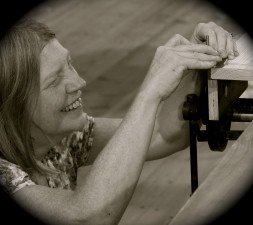
Preparing for the first teaching I ever did took a few weeks. As a collector user, I had enough for ten students and kept the class simple. Unbeknownst to me, what I put together back then would undergird my future belief and that was that with three joints and ten hand tools you could make just about anything from wood. I am so glad that I worked from the experience I knew worked and had worked for me for a couple of decades then. I never copied other woodworkers, teachers or existing schools. Simply put, I made the three joints and put the tools aside as I used them. That gave me the cluster I have used throughout my teaching. It was from this that I came to ultimately write my much-needed second book, Essential Woodworking Hand Tools. There is a story in that too. Perhaps I will get to it later.
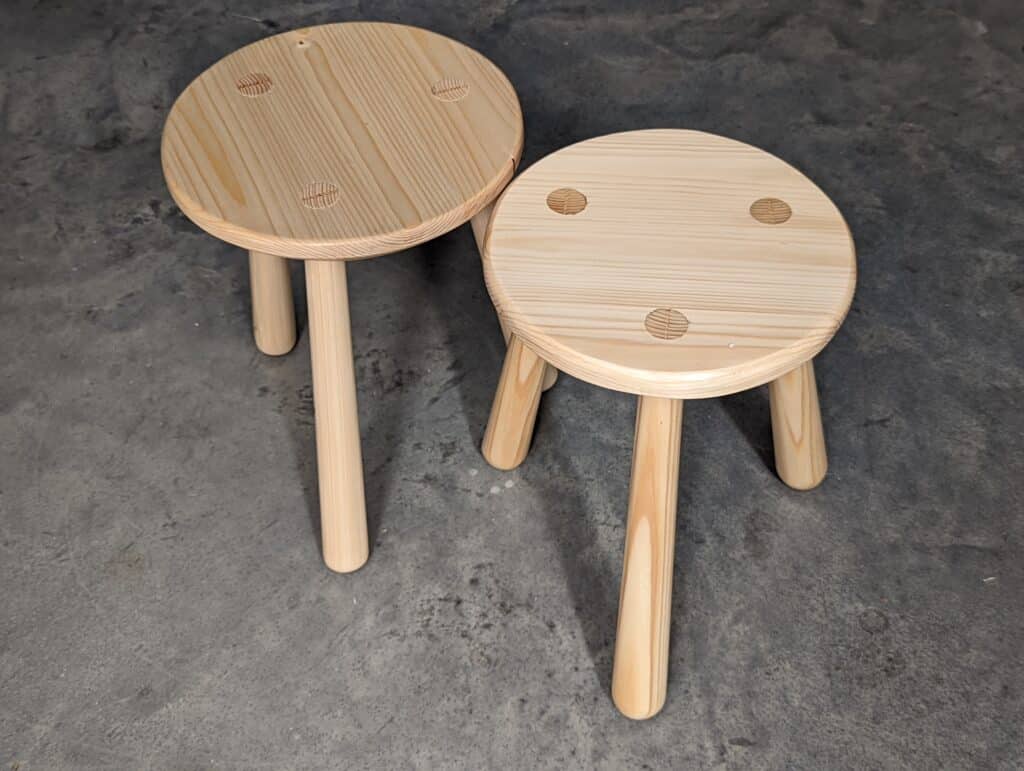
The three-legged stool above came from eight hand tools. They can all be used throughout woodworking. Of course, ten hand tools were pretty minimalist, thirty would be nearer meeting the needs of we woodworkers. The idea of course was to help others to understand what the real and true needs really are and that you don’t need say a #6,#7 or #8 bench planes, a #4 and possibly a #5 will take care of almost everything when you master the skills. Yes, others are nice to have as and when you come across them or you can afford them. No need for a £120 coping saw when a £5 secondhand Eclipse works perfectly well. Even cheapo chisels are not like the imports of old in the 1960s when they inevitably snapped in two under the slightest pressure. That said, the only chisel I ever had snap was a UK-made premium chisel. Probably just a lone bad one but still offputting enough. I think the days when you said imports of cheapos are no good are gone. You can buy a set of four chisels that will take and hold a keen edge acceptably well for around ten pounds or dollars. The handles may be a tad small, the finishes a bit rough, but they will cut dovetails for a year or two to get you started. I have cited the #4 as the only true essential plane for woodworkers if they must choose. It’s not the actual plane but the width and length of it. A couple of inches wide and around 9″ long is what we call a smoothing plane. With this, you can prep stock for joinery, true up surfaces for finishing and trim off any amount you need to. Heavy set people might go for the wider #4 1/2 and though a #4 will well suit most of those of us of average size, the #3 is a good choice for those of a slighter build. For a one-size-fits-all plane, the #4 does it. If I had no other bench plane the #4 would suit me the best. You should be able to pick up a #4 Stanley or Record for around £20-30. It will last you a lifetime of daily use, no question about it.
As I set up for the workshop I found myself outdoors under a newly raised brush arbor at the back of an outdoor sports stadium. They thought it would add interest to recreate the pioneer spirit for the student and it worked surprisingly well to conjure up that same spirit of adventure. As I laid out the tools at 7 am I felt excited. Who would come? Men, women, professionals, older children? I had no idea. As I ran through the tools, touched the cutting edges, and placed them as a set per person, my mind ran riot thinking about what it must feel like for the attendees. At 8 am they all stood around the bench and introduced themselves, giving a brief overview of why they’d come and then too what their expectations were. The men dressed the part a little more than the women. That was mainly because their exposure was likely longer term and they had the edge. In actuality, the men kind of overdressed with an image they thought to be of a working carpenter if you will. Side pockets now called cargo pants and suspenders (braces UK). A bandana around their necks or heads, that kind of thing. Even a red handkerchief floaty dangling from a back pocket here and there seemed to complete the outfit. I get it. But there was a woman there who made a statement that really stuck with me. ” I truly hope I don’t make a fool of myself in front of you guys. I have always wanted to learn woodworking from a skilled craftsman and here I am. Be patient with me ‘cos I’m a slow learner doing something I was never allowed to do!” She looked to be about 60. I felt sad in the truth of it. I’d heard this many times from women who wanted to do woodworking but never could. That she had had to wait so long for something that is very much a non-gender specific class remains even now. Ingrained expectations and attitudes that seem never to change very much a all. I was glad to be the bridge for all these people. Having the right tools and insights was a freeing experience for us all.

Slicing into the wood, a sharp saw held a gaze in a mesmerising way. Chisels sharpened keenly gave them cuts they never dreamed possible, a totally new concept yet one they suddenly saw as essential. I explained that the true accuracy of all things craft revolved around the sharpness of the tools they would use and then too the engagement of their physical bodies applying precise pressures and direction. Peeling off shavings with planes one after the other slowly came and this seemed the most conclusive insight as to exactly what sharpness was. As we closed out the day, each one of them took their three joints along with practice pieces, the scraps from the joints and even the shavings. Such small things speak volumes of overcoming doubts and fears. We should never despise the days when small things become universally big. Men flew and walked on the moon only two decades before. This for them was their moon landing, surely.
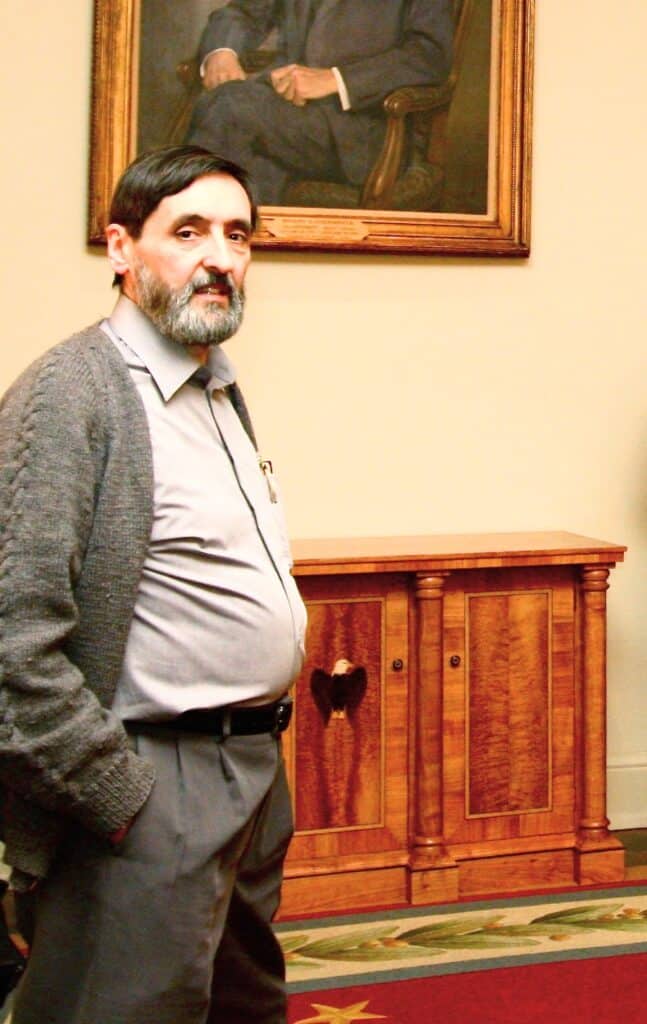
This, my friends, was the spark that lit the fire to my life becoming the maker teacher I never thought to become. I didn’t do it to create a business because I couldn’t make it as a maker I did it because I had a burden for my craft. A constant flame began and it took only a year or two before I was able to begin a full-time woodworking school in central Texas. I continued furniture making as part of my income-producing life all the way through from that day until 2008/9 when the last US pieces I made would be the ones I designed for the Cabinet Room of the White House. That passage saw the start of establishing the first woodworking school in Texas and many surroundings states too. Back then there were only a handful of schools in the whole of the US. It was from this raw beginning that I began to write magazine articles, the woodworking curriculum I would use for three decades to date, and go on to write books, articles and how-to booklets. Today we have provided thousands of hours of video content to replicate everything I ever taught one-to-one in classes. The craft of hand working in wood is more alive today than it would have been without that beginning class at the state fair. Those were the years of the greatest demise when machining would was king. In that day there was almost no hand tool woodworking to be seen anywhere. Not so today.


Wow.
Having spent a decade in Dallas Texas I wonder what was your impetus in moving from a cool climate like the UK to a pretty warm one in central Texas and vice versa.
Shrugging off the old to put on the new. The heat never really bothered me too much (except in Houston from April to October, so I never went there anyway except once to deliver a piece of furniture to a lawyer in a high-rise office). I learned not to drink iced drinks because I could never get enough hydration with water so cold. I live a time I could never repeat in a wilderness I loved where ranches could be 36 square miles and my near neighbour, former Texas governor, Dolph Briscoe, was the biggest independent land owner in the whole of the USA with a million acres under his belt that surrounded my little half-acre. How wild is that and how wild do you need? Oh, would I repeat my immigration and the experience? Yes, I think I would. I was disillusioned with England at the time for a few reasons but The US helped me to reconsider life, gave me a new perspective and a rebirth; it also gave me a freedom I never new existed . . .or was that Texas? Hmm, yup, Texas and the USA.
Growing up in Texas you heard there were only two seasons. “Hot and fixing’ to get hot.”
Let’s get paul back! He and his kids are an American treasure and our country is far the poorer (and dumber) for letting them escape!
I saw a show/interview with an original promoter for ZZ Top. He couldn’t figure them out, it was like they were from different country. He finally realized they essentially were, they were from Texas… : ) -JMS
Thanks for sharing your story Paul! It was very inspirational for me.
Hello Paul,
What a fascinating insightful story on where it all began. Thank you for sharing it with us.
I realise you are extrely busy with all your work streams, but I was wondering would you consider writing another book? I am sure I am not the only one who would enjoy reading about your journey, from your apprentiship days with George to the hurdles/challenges you had to overcome to get to where you are today.
Thank you for everything so far.
Stay well
Stephen
An amazing life’s story.
Sad that people were told that they weren’t allowed to do something.
I would like to think we have made some advances in society over the years.
When I was growing up I was encouraged to try my hand at anything I chose to do.
There was no real instruction, except on how to use power tools safely.
I remember in school lining up to take your turn on the bandsaw or table saw after being instructed on its use and dangers. I was afraid to use the jointer after one of the guys lopped his thumb off on it. We had hand tools galore but none of them sharp and they weren’t used because “they didn’t work” of they were for younger boys because you couldn’t hurt yourself as badly.
It sounds silly but I was in my twenties when I finally realized that the planes and chisels I had didn’t work because they were dull. Even then it took me a long time to sharpen them and then I didn’t want to use them because it took so long to sharpen them and so short a time for them to get dull.
Thanks for what you have taught me, I wish I had the knowledge then that I have now.
You know, that is only one-thousandth of the story; the tamest part. One day it will be finished. I think the whole will blow your socks off!
Paul,
Don’t put off “ the rest of the story”. Because it is a truly extraordinary and inspirational one. Put me on the list to buy the book as soon as it’s ready…..
In the meantime, I am really fascinated by your ‘Three Joints, Ten Tools’ concept. It is pedagogically brilliant because it simultaneously simplifies and removes excuses for not trying it.
Is there someplace you have written about it that I have missed?
Keep writing!
I have learned a great deal from your videos and articles.
I would be especially interested in knowing what it was about England at the time that made the USA so attractive.
Today, as you know, there is a great undercurrent of hatred for America by many who were born and raised here and have little life experience.
They are young revolutionaries who intend to change America the way the red guard changed China.
For me, it was life-changing the change from the UK life to life in the USA. Yes, it doesn’t have it all together, has problems. whatever. Young revolutionaries have a fight to fight and a right to fight too, wherever they are, as do old revolutionaries like myself. Seeing a way out spurs us on in the face of adversity. I just wanted out of Britain for a season that’s all. I love the English countryside desp[ite the polluted way we abuse it with the way we live. I’m hoping the change will come simply because we need to take care of what has been given to us. My revolution flies in the face of adverse attitudes to my craft and methods of working. It’s been slow but it’s also been impactful. If I died today I would be content with how far we have come.
A colleague told me a story of his high school shop experience / power tools. The instructor started safety instruction by saying he would (try to) never say/ask: ” OMG ! How did you do that ??!” because in a previous class, a kid cut his finger in the power saw, and upon that exclamation (from the instructor), the kid turned around and showed him, by cutting another finger ! -JMS
So fortunate we are to have a mentor like yourself freely providing videos and the technical know-how to the craft of hand tool woodworking. Thank you for sharing your past and the inspiration to us as woodworkers, those learning and those yet to discover the joy and satifaction that comes with transforming wood into useable items. Indeed sharp tools make all the difference…
Thank you Paul for sharing your knowledge and skills so freely! I have learned from your YouTube videos and appreciate your concise, practical instructions as I watch you create something in real time. You have a teacher’s gift for providing instructions and encouragement in proper measure.
I’m glad you made the decision to teach.
OMG you were just a BABY.
Now look at what you’ve done.
Which shows that real revolutionaries don’t throw bombs, they build stuff and teach other people to build stuff.
Greatest quote…two thumbs up
Too true, you’ve hit the nail on the head ……. only Paul doesn’t use nails too often.
I would enjoy reading your book also when it becomes available, I have some fond memories of visiting my late uncle when he lived in the hill country on 10 acres between Kerrville and Ingram, so put me on your list if there is one yet. I enjoyed the good read, Thanks for sharing.
Thank you, Paul. It’s always a benefit to hear the perspective of others, especially in a country as sprawling as the US. Myself, I am a California, descended from Californians for 160 years. I am still surprised at the strange views that outsiders have. Every Texan I have ever known, and that is several, was a kindly, humorous person.
Great post, Paul – and so serendipitous!
I just moved to Georgetown from Dallas about a year ago, and finally have my workbench in place and wood laid out for more crafting. I was just working this past weekend in my garage applying the stain and glue-up of your wall-mounted shelving unit, as I continue my (nearly complete!) journey through your Working Wood 1 & 2. I’m one end table away from completing all your projects, and I have a piece of quarter-sawn white oak that I’m very excited to laminate for the table-top! The real heat has started to break early this year, which I’m grateful for: July was the biggest bear this year so far. I get to take off the clamps tonight. I can’t wait.
It still amazes me to think that had you not flown half-way across the world to set up shop in my Texas, 3 years before I was born, I’d have never picked up this enduring hobby! I grew up in a family that always deferred to the experts to fix things or make things; you’ve made crafting accessible for me. I can never thank you enough! I’m constantly amazed by the intersection of romantic and technical beauty that I continually encounter when I’m wood working. The dialed-in instrument takes a shaving, the grain is exposed, a joint comes together perfectly. It’s difficult for me to convey my excitement to others as I stand in awe at the tools, the materials, the methods, and the finished product; but I often think of another Englishman whom I greatly admire who once said, “It’s better to be the bore than the bored.”
…and forgive me if I misquoted G.K. Chesterton!
Thank you Paul for your wonderful USA story. And for me, it was very special, as I know and have been to all the places and towns of which you speak, having been stationed in San Antonio, Texas while an officer in the United States Air Force and training there at Wilford Hall hospital. It is definitely hot in the Summer there, a lower humidity heat they say, but at over 100°F it matters little.
Cheers.
Michael
Being a Houston native with family in the Hill Country (and in every corner of the state), these are my favorite PS posts. Both for reminding me of the utter glory of the central part of our state, and for sympathizing with the the misery of Houston’s heat. It’s called Bayou City because it is a bayou, not because it has bayous. The only nice part of woodworking in a bayou is you never have to knock down any raised grain in the summer — you’ll have poured enough sweat onto the piece to have it all raised before sanding!
Really though, in every Texas post you capture the best of our state, and I appreciate that. It’s how I grew up thinking about Texas, a big wide open beautiful place with space for everything and everyone. A few years older now, it’s apparent that reality is a bit more complicated than I thought. But it’s still an ideal that we as Texans can strive for.
The woodworking content is great, even invaluable. Life changing. But the Texas content is home.
Still need to head out toward Austin one day and pick up some mesquite.
Thank you Paul. Really enjoyed your story.Two days ago I sent away for and got the chisels you recommended on your website. I am trying to to put a work shop together and hopefully enjoy woodworking as much as you do. I am a late starter at 72. Thank you for the inspiration. I hope to get my tools sharp enough to work efficiently.Thanks again!
Thank you Paul you have helped so much and so many others in learning woodworking. I truly appreciate you.
Carlos
I sit on my front porch drinking my coffee, peering though the woods in front of me, listening to all the birds tweeting their songs while reading your philosophical writings of days gone past. It makes me walk through many sentimental sweet memories of my own. Your article is only second to your work and much appreciated. Thank you Paul.
Hello Paul,
Thank you for all this shared experience and life part.
I don’t really have anything to ask or say, i was moved by your text,, and would feel like a robber to leave this page without a comment for it as move something inside me.
I m managing director for over 200 people at 35 … and if i count well this first class was around your 35 also ( you say learned 20 years past, and many post state you started around 14).
Many are the days i take my keyboard hoping i’d take my #4, I m into wood working for a year now ( mostly thanks to you, and full hand toolist .) i m still doing work way below my expectation, but most is gapless and let’s say …”acceptable” (not that this mean anything as it is very subjective).
Anyway, glad you this turn of your life found you and impressed by the fact you actually had the courage to take it.
I for my part (as a father of 3) stay in the fear for their future as i can’t see any way of living of my passion, this will stay as long as I responsible for them, a hobby. But as you mention in other post … amateurs keep this craft alive.
Best Regards,
It’s a nice thought,Vivien. I am not sure how many parents have the ability to steer their children as mine did me. I was fortunate to be told by the head teacher of my school, along with my parents, that I could never be educated. What he meant is our system does not cater to a certain type of child because we cannot shoehorn him into the categories we have. Mt father encouraged me asking what I wanted to do with the rest of my life and I said I want to be a woodworker. That single strand gave me the hope and the springboard I needed. I don’t think parents usually ask their children such a question for fear they might say a rock climber or a plumber. The filter from childhood is quite ridiculous and yet all parents seem to rely on something very vague called higher education. Most graduates, it seems at least a large percentage, never actually use their degrees except to show they have one.
Thank you so much for your encouraging words though. I didn’t mean to rant there. Just I wish parents would truly engage with their children to steer them along a path that they feel strongly about. I got by fine with no degree at all and I didn’t miss it. I’m at the older end of my life with remarkably few regrets.
Hi Paul,
I live close to where you were in TX. That specific area has a unique look and feel to it. And the wildflowers can be quite dazzling some years. I think you have 3-4 years on me but I can relate to much of what you write. A few things would like to bring up. 1. It would be great if you or your staff could set up a way for others of like mind to contact one another. I know there are others posting here that live close to each other and might like to share some time together in pursuit of their woodworking passion. 2. I have an opportunity to teach woodworking to some kids ages 9-14 at a youth camp but am struggling to know where to start with projects that would give them a sense of accomplishment in a span of 5-10 hours over one week. Thoughts and ideas would be welcome.
Hi Paul. It must have been a really brave thing to move to a new country with a young family and in such a remote location. How long did it take you to become established in the wood working environment and the communitiy and was it a cultural shock having grown up in the UK?. Did you ever ask your self “have I done the right thing” in the early days. What made you decide to come back to the UK after successfully settling in the US. Sorry for so many questions. I find your story so inspirational, thanks for sharing it with us.
I can’t really answer so fully because the journey unfolded over so long a period. 23 years is a long time in the grand scheme of things. No, it wasn’t a brave thing it was exciting. Speaking a similar language helped. To describe it as a cultural shock too, well, putting your kids on a school bus for 32 miles and meeting the bus 7 hours later was different than walking 500 yards to the school gate. Oh, and driving 8 miles to meet that school bus was different too. No, I never asked those questions. And you might remember that I did this having been told that I had an incurable disease with 18 months before I would require major surgery to extend my life by a few years. Did I tell you I had three children at the time and I couldn’t get health insurance either? Must have forgot that. Well, I am still here, never did have the surgery. Stupid? Probably. Would I change it? No.
By some good fortune I came upon this essay. We have a cabin in the north woods of the Upper Peninsula of Michigan. The trees provide some nice “orphan” wood….. pieces that I find and put aside to make things. My skills have been greatly enhanced by watching your videos.
You really captured the spirit of the Hill Country. I never understood the passion Texans have for Texas until my son moved there and I visited for the first time.
Using hand tools keeps us connected to the unique qualities of each individual piece of wood. You help us acquire the skill to do justice to whatever we are working on.
I’m so glad your path in life led you to sharing your knowledge….
and your story!
A few years back I purchased all the power tools I thought I would require to manufacture the odd cabinet for a hobby. As luck would have it, I found myself unemployed 3 years ago and had some time on my hands. I finally found the time to build some cabinets for our walk in closets. My father donated the wood that was milled from a monster pine, 30 years ago and seasoned a in his basement for all those years. The boards were planed on a thickness planer, many hours! The process then followed with the framing and the manufacture 18 raised panel doors of a few different sizes and styles. The largest requiring some home made clamps. It started as fun and soon became repetitive production. I was dealing with saw dust and boredom. I really thought that this was not the hobby for me.
I happened on a Paul Sellers video and I began to see the light. I remembered what it was like to carve small toys with a pen knife when I was a boy. I dusted off a block plane that my father had gifted me and honed it to a razors edge and made some beautifully thin shavings. The silky smooth finish amazed me.
I have since taken up the old techniques and am totally enjoying every dovetail, mortise and any other joint I can master. Thank yo Mr. Sellers!
At middle school in the UK (toll age 13) I had a teacher I liked – he also taught woodwork and darkroom photography clubs. I lived both, but when I went to secondary school, the workshop had been replaced by a brand new ‘design technology’ building. I was disappointed to discover we rarely made anything, and what we did was of plastic. Now in my 40s I have a shed with two rooms – at the front a workbench and at the back a darkroom. I’m just sad about the intervening years where I was encouraged to neglect my own creativity.